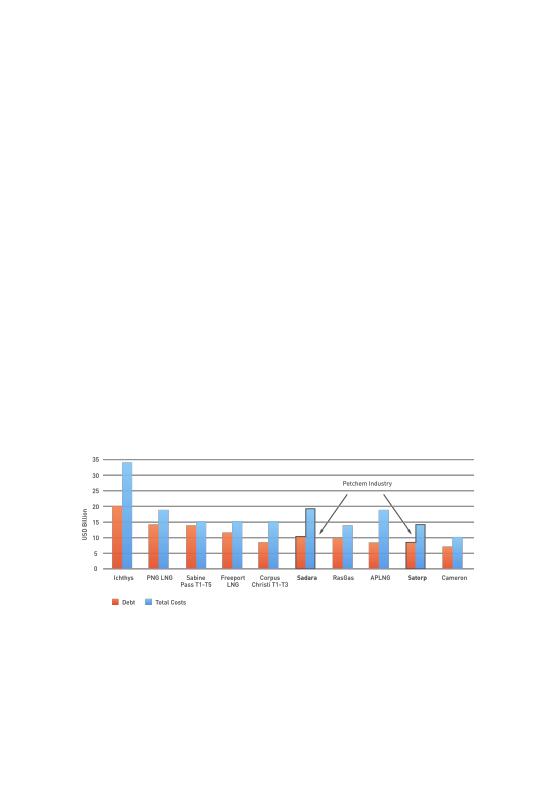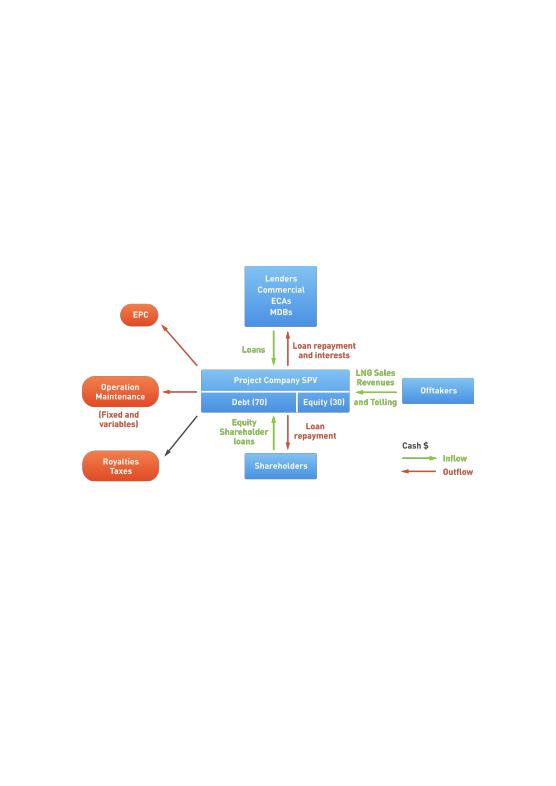
01 POWER ISLAND / 01 CCPP / DOE__Understanding Natural Gas and Lng Options October 11 2017_1
.pdf
LNG AND GAS CONTRACTS
Financing Agreements
If project financing is used, a large number of financing and security agreements will need to be entered into.
Transportation Contracts
Either the seller or the buyer will need to contract for LNG vessels to transport the LNG to the market. The options are: (1) own the LNG vessels, or (2) charter the LNG vessels.
In a vessel-ownership model, an LNG vessel shipbuilding agreement will be required.
A vessel-leasing model will typically be either a bareboat charter (charterer provides crew and fuel), voyage charter (owner provides crew and fuel for a single voyage), or a time charter (owner provides crew and fuel for a set period of time).
Facilities Sharing Agreements (FSA)
An FSA applies to LNG complexes with multiple LNG trains and differing ownership between trains. When any new train is built, in addition to the cost of the train itself, the new entrants are required to enter into facilities sharing agreements. These provide for payment of their share of common facilities, such as LNG storage, power generation, and LNG berths, etc.
Terminal Use Agreement
In an LNG import project, depending on the project structure, the user of the terminal will enter into a terminal use agreement with the terminal owner. There are a wide variety of titles for this agreement, although they accomplish the same purpose - use of the terminal for a fee.
156

Financing an
LNG Export
Project
Introduction Project Finance Structure The Financing Process Available Funding sources
Impact of Market Shifts on Project Finance

FINANCING AN LNG EXPORT PROJECT
Introduction
This chapter introduces the basic concepts involved in the financing of LNG export projects and associated infrastructure. Although some projects, such as Nigeria LNG (1 and 2), and Gorgon in Australia, were financed directly by their sponsors, the more common method of raising capital has been through a staged project finance structure. This chapter, therefore, focuses on finance structures followed by a discussion of the finance process, various funding sources, and impact of the current state of the global LNG markets relative to Africa.
The first project financing transaction in the LNG sector was for Australia's Northwest Shelf in 1980. Since then its use has become routine and project finance has been used in Africa in many different types of large projects, including by Nigeria LNG (NLNG 3-6). Ranked by debt, LNG projects occupy eight of the top ten slots for all project financing completed globally between 2005 and 2015, as shown in the chart below:
Source: Poten & Partners' LNG Finance in World Markets, LNG in World Markets, published company reports
158

FINANCING AN LNG EXPORT PROJECT
In project finance, all of the development cost, assets, permits and contract rights of the project company are used to support the finance structure. The credit of the project company's counterparties is used rather than the credit of the project sponsors that create and own the project company. The project lenders rely on the cash generated by the project (e.g. LNG sales contract duration/revenue forecast) to pay back the debt and not on the balance sheets of the project sponsors. For this reason, it is also referred to as 'off balance sheet financing' and 'limited recourse financing.'
Given the magnitude of the capital required for LNG projects, most are implemented by more than one project sponsor and require multiple funding sources. Government and corporate sponsors are often unable or unwilling to provide sufficient sovereign or corporate credit to finance LNG projects. Project finance structures provide reasonable protection for all parties and contractually protect against the contingent liabilities of partnership.
To implement a project finance transaction, project sponsors establish a special purpose vehicle (SPV) that allows banks, export credit agencies (ECAs) and other financiers to lend money directly to the project company or specific assets (e.g., LNG Train 3) instead of to the individual project sponsors. Currently, all liquefaction projects require long-term 'take-or-pay' LNG sales or tolling contracts to allow them to raise funding through project and equipment finance structures. Because the assets, permits and contract rights of the project company are the sole sources of debt service, international project finance involves careful analysis of the various risks associated with the project. New insurance products such as first loss policies or environmental protection insurance are bringing new sources of funding such as pension funds. The agreements to which the project company is a party must be precisely drafted in order to ensure that these risks are properly identified and allocated among the project company's counterparties.
159

FINANCING AN LNG EXPORT PROJECT
Project Finance Structure
The following diagram depicts the relationships between the project sponsors and the financiers and the cash flows:
>Debt to equity ratio: As a result of the large cost of LNG projects, they are typically highly leveraged. A target of 70:30 debt to equity ratio is the norm. The project partners will provide the equity and sometimes bring in other financiers to provide equity. The debt is typically provided by banks and other lenders. Consequently, a large proportion of project sponsors look at generating large amounts of debt, but in project finance, this is located off balance sheet. So using project finance will allow sponsors to maintain their corporate debt/equity ratio.
>Limited recourse to project sponsors: LNG project finance is essentially based on “limited recourse” finance, which means that the
160

FINANCING AN LNG EXPORT PROJECT
loan is given to a Special Purpose Vehicle (SPV) instead of the project sponsors. As a result, lenders rather than sponsors assume the lion's share of risk associated with the project. However, during the development phase of the project, the sponsors (or shareholders) usually provide financial cover to the lenders until startup and completion tests are met. This is provided via a completion guarantee. Equally, shareholders would try to pass on some of the risks to the engineering procurement and construction (EPC) contractors. EPC contractors provide the shareholders with security via a lump sum turnkey contract, which means that the contractors have to shoulder the risk if there are problems with plant performance during startup leading to delays. When production starts and targets are met with proper completion tests, financial recourse to sponsors is canceled. This differs greatly from traditional balance sheet based loans.
>Public-Private Partnerships in higher-risk countries: LNG projects always require government support, this is for political reasons, risk mitigation, regulatory framework matters, interactions with communities, and contract stability and enforcement. Often the government (national or regional) is a shareholder in the project. The government may not be in a position to access finance to contribute equity or other development costs, and equally, investors may not be willing to cover the government's development costs. The role of project finance is to ring-fence the project and enable the project company to borrow money under its own name, accessing terms more favorable than the government would obtain, thereby reducing the impact of the low credit rating of the host country.
>Special Purpose Vehicle: In order to successfully implement a project finance transaction, project sponsors typically establish a special purpose vehicle (SPV) that allows banks, export credit agencies (ECAs) and other entities to lend money directly to the project company instead of to the individual project sponsors. By comparison, if corporate finance was used, each sponsor would be required to finance its portion of the project, using a combination of capital on hand and individual loans, which would limit the amount of debt that can be raised by entities with lower credit ratings.
>Offshore ventures: In some instances, the project developers also create an offshore account that will receive cash inflows from lenders,
161

FINANCING AN LNG EXPORT PROJECT
equity from shareholders, and LNG sales revenues. Debt will be serviced from this offshore account. While this does not mean that the SPV is exempt from tax in the host country - which is usually regulated by law and negotiated contractually - this serves to mitigate country exposure both political and economic, as well as facilitating cash flows that could be compromised by host country banking system performance. Offshore ventures are regulated and negotiated contractually to enforce international law and U.S. Foreign Corrupt Practices act agreements and equivalent.
>Loan tenor/payback period: Debt is provided by a syndicate of lenders (such as commercial banks, pension funds, investors in the public bond market, export credit agencies and government-backed lending institutions), who differ in terms of the amounts they lend, lending conditions as well as the ranking in the order of repayment. A typical loan tenor (meaning the time left for loan repayment) commercial banks would accept for LNG projects would be 10 years for high-risk countries. The tenor terms are based on a debt service coverage ratio which can be determined using financial models. The loans are priced at a margin applied above the base rate, which is often the London interbank offered rate. The loan pricing or margin will depend on an assessment of a project's risk and on the cost of funding. Multilateral Development Banks (MDBs) such as the International Finance Corporation (IFC), Africa Development Bank (AfDB), and European Investment Bank (EIB), have specific loan products that can offer more favorable tenor terms though they usually constitute a small proportion of the total debt amount. Because of the time necessary to recover the capital investment costs - typically around 7 years - longer tenor terms are favored by project developers.
>Long-term sales-and-purchase agreements: Firm long-term agreements among LNG exporters and importers are generally required for up to 80% of the project's capacity. They typically cover contract periods of about 15 to 25 years, thus exceeding the anticipated loan payback period - normally in the range of 7 to 15 years. However, shorter term contracts are becoming more prevalent (see section below).
>Inputs from ECAs and MDBs: The lengthy and thorough due diligence process involved in a project finance transaction, together with the
162

FINANCING AN LNG EXPORT PROJECT
economic development implications and the importance of the political environment, is well suited to ECA and MDB involvement. Since the mid-1990s, MDBs and ECAs have played a growing role in structuring LNG projects. They can finance them through direct loans, political risk coverage or loan guarantees (see the section on Available Funding Sources below).
>Risk mitigation: A key advantage of project finance is that it allows developers to mitigate the risks associated with politically or economically unstable environments. Such projects face a risk of expropriation, political turmoil, labor strikes, land rights issues, and other unforeseen disruptions.
>Debt recovery and default rates: Experience has proven that the use of project finance for liquefaction projects has resulted in remarkably low default levels.
Project financing can have its drawbacks. Because banks lend to a project company, with limited recourse to the actual project sponsors, the due diligence requirements take time and money. While these drawbacks are significant, liquefaction project sponsors have historically found project finance advantages outweigh its drawbacks. But they tend to use it only when it allows them to finance projects with weaker credit partners or at the behest of national oil companies.
163

FINANCING AN LNG EXPORT PROJECT
The Financing Process
The time taken to arrange project finance will depend on the development processes, project cost, the risks associated with the project and the host country, and number and type of financiers needed. Also, external market conditions such as commodity prices and the amount of liquidity in financial markets and foreign currency fluctuations will have an impact on timing. The size, complexity, and scope of major LNG projects require a wide range of advisors both on the side of the investors and the host government, together with the commitment of substantial resources throughout the financing process by both the government of the host country and the project sponsors.
This process, from initial discussions to finalizing the financing (financial close), can take as long as two years. In countries with little experience in the sector, or without appropriate policy and regulatory frameworks, the financing process can take much longer. Companies typically appoint a financial advisor to help structure the deal. The financial advisor will be appointed at the same time, usually, as the legal and technical advisors. The financial advisor is often selected from a group of advisors known by the commercial bank community. In addition, development banks, such as the IFC and the African Development Bank, can also be appointed at an early stage to provide advice on financial structuring.
Reserves will be delineated, the project company will be formed and will obtain its permits and licenses, and the project agreements will be structured, negotiated and executed by the stakeholders, including the government. Each of these tasks will require commercial, technical and legal resources. The financing discussions will start concurrently with FEED studies and tenders for EPC contractors. Often companies and their advisors will hold initial talks with the banks - known as "soundings" - in order to gauge their interest in participating in the project financing and to pinpoint any impediments to fund-raising.
164

FINANCING AN LNG EXPORT PROJECT
Early in the process, the financial advisor will consider equity as a source of finance. Assessing the amount of equity available for the project will determine the "gearing" ratio and the amount of debt that the project needs to raise. The project will reach out to potential interested shareholders, typically parties with a specific interest in the project, such as off-takers, tolling counterparties, or EPC contractors and/or entities that have a large amount of liquidity available and looking for long-term stable returns with limited risks. These entities could include pension funds.
On the debt side, the financial advisor, with input from the project sponsors and their advisors, will produce an information memorandum and financing request for proposal (RFP) which will be sent to banks. This will contain all the pertinent details that are needed by potential financiers to assess the project. It will include details on the LNG offtake or tolling contracts, as encompassed in the sales and purchase agreements or tolling agreements. The information memorandum will include details on project construction, EPC contract, and timeline, plans for shipping, and operations and maintenance details. Technologies used will also be detailed. Banks do not have a strong appetite for exposure to new technology risk, so adequate protections, provided by sponsors, need to be in place if anything untried is introduced. This is the case for early floating liquefaction units, but lenders' concerns can be dealt with by use of a sponsor completion guarantee which is only released once the unit is operating according to parameters specified in the documentation.
The information memorandum will also include environmental protection and remediation. When assessing the environmental and social impact of projects, many financial institutions will use a risk management framework called the Equator Principles. As of the end of 2016, 85 financial institutions across 35 countries had adopted them. They include some of the big commercial banks which can find themselves a target of NGOs if they do not meet social and environmental standards when funding projects.
The financiers will be provided with commercial and financial models in tandem with the information memorandum. They will use various ratios to assess the project's risk, one of the most important being debt service coverage ratio (DSCR). The company and its advisors may provide indicative pricing in the model for the debt, although this will be decided based on market considerations.
165
